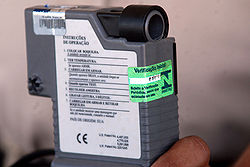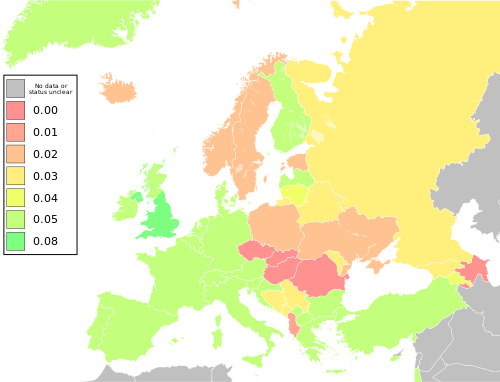Personality traits
Although situations differ and each person is unique, some common traits have been identified among drunk drivers. In the study "personality traits and mental health of severe drunk drivers in Sweden", 162 Swedish DUI offenders of all ages were studied to find links in psychological factors and characteristics. There are a wide variety of characteristics common among DUI offenders which are discussed, including: "anxiety, depression, inhibition, low assertiveness, neuroticism and introversion". [29] There is also a more specific personality type found, typically more antisocial, among repeat DUI offenders. It is not uncommon for them to actually be diagnosed with antisocial personality disorder (ASPD) and exhibit some of the following personality traits: "low social responsiveness, lack of self-control, hostility, poor decision-making lifestyle, low emotional adjustment, aggression, sensation seeking and impulsivity". [29]
It is also common for offenders to use drinking as a coping mechanism, not necessarily for social or enjoyment reasons, when they are antisocial in nature and have a father with a history of alcoholism. Offenders who begin drinking at an earlier age for thrills and "fun" are more likely to be antisocial later in their lives. The majority of the sample, 72%, came from what is considered more "normal" circumstances. This group was older when they began drinking, came from families without a history of alcoholism, were relatively well-behaved as children, were not as physically and emotionally affected by alcohol when compared with the rest of the study, and had the less emotional complications, such as anxiety and depression. The smaller portion of the sample, 28%, comes from what is generally considered less than desirable circumstances, or "not normal". They tended to start drinking heavily earlier in life and "exhibited more premorbid risk factors, had a more severe substance abuse and psychosocial impairment." [29]
Various characteristics associated with drunk drivers were found more often in one gender than another. Females were more likely to be affected by both mental and physical health problems, have family and social problems, have a greater drug use, and were frequently unemployed. However, the females tended to have less legal issues than the typical male offender. Some specific issues females dealt with were that "almost half of the female alcoholics had previously attempted to commit suicide, and almost one-third had suffered from anxiety disorder." In contrast with females, males were more likely to have in-depth problems and more involved complications, such as "a more complex problem profile, i.e. more legal, psychological, and work-related problems when compared with female alcoholics." [29] In general the sample, when paralleled with control groups, was tested to be much more impulsive in general.
Another commonality among the whole group was that the DUI offenders were more underprivileged when compared with the general population of drivers. A correlation has been found between lack of conscientiousness and accidents, meaning that "low conscientiousness drivers were more often involved in driving accidents than other drivers." When tested the drivers scored very high in the areas of "depression, vulnerability (to stress), gregariousness, modesty, tender mindedness", but significantly lower in the areas of "ideas (intellectual curiosity), competence, achievement striving and self-discipline." [29] The sample also tested considerably higher than the norm in "somatization, obsessions–compulsions, interpersonal sensitivity, depression, anxiety, hostility, phobic anxiety, paranoia, psychoticism", especially in the area of depression. Through this testing a previously overlooked character trait of DUI offenders was uncovered by the "low scores on the openness to experience domain." [29] This area "includes intellectual curiosity, receptivity to the inner world of fantasy and imagination, appreciation of art and beauty, openness to inner emotions, values, and active experiences." In all these various factors, there is only one which indicates relapses for driving under the influence: depression. [29]
Cognitive processes
Not only can personality traits of DUI offenders be dissimilar from the rest of the population, but so can their thought processes, or cognitive processes. They are unique in that "they often drink despite the severity of legal and financial sanctions imposed on them by society." [30]
In addition to these societal restraints, DUI offenders ignore their own personal experience, including both social and physical consequences. The study "Cognitive Predictors of Alcohol Involvement and Alcohol consumption-Related Consequences in a Sample of Drunk-Driving Offenders" was performed in Albuquerque, New Mexico on the cognitive, or mental, factors of DUI offenders. Characteristics such as gender, marital status, and age of these DWI offenders were similar to those in other populations. Approximately 25% of female and 21% of male offenders had received "a lifetime diagnosis of alcohol abuse" and 62% of females and 70% of males "received a diagnosis of alcohol dependence." [30] All of the offenders had at least one DWI and males were more likely to have multiple citations. In terms of drinking patterns approximately 25% stated that "they had drunk alcohol with in the past day, while an additional 32% indicated they had drunk within the past week." [30] In regards to domestic drinking, "25% of the sample drank at least once per week in their own homes." [30] Different items were tested to see if they played a role in the decision to drink alcohol, which includes socializing, the expectation that drinking is enjoyable, financial resources to purchase alcohol, and liberation from stress at the work place. The study also focused on two main areas, "intrapersonal cues", or internal cues, that are reactions "to internal psychological or physical events" and "interpersonal cues" that result from "social influences in drinking situations." [30] The two largest factors between tested areas were damaging alcohol use and its correlation to "drinking urges/triggers." [30] Once again different behaviors are characteristic of male and female. Males are "more likely to abuse alcohol, be arrested for DWI offenses, and report more adverse alcohol-related consequences." However, effects of alcohol on females vary because the female metabolism processes alcohol significantly when compared to males, which increases their chances for intoxication. [30] The largest indicator for drinking was situational cues which comprised "indicators tapping psychological (e.g. letting oneself down, having an argument with a friend, and getting angry at something), social (e.g. relaxing and having a good time), and somatic cues (e.g. how good it tasted, passing by a liquor store, and heightened sexual enjoyment)." [30]
It may be that internal forces are more likely to drive DWI offenders to drink than external, which is indicated by the fact that the brain and body play a greater role than social influences. This possibility seems particularly likely in repeat DWI offenders, as repeat offences (unlike first-time offences) are not positively correlated with the availability of alcohol. [31] Another cognitive factor may be that of using alcohol to cope with problems. It is becoming increasingly apparent that the DWI offenders do not use proper coping mechanisms and thus turn to alcohol for the answer. Examples of such issues "include fights, arguments, and problems with people at work, all of which imply a need for adaptive coping strategies to help the high-risk drinker to offset pressures or demands." [30] DWI offenders would typically prefer to turn to alcohol than more healthy coping mechanisms and alcohol can cause more anger which can result in a vicious circle of drinking more alcohol to deal with alcohol-related issues. This is a not the way professionals tell people how to best deal with the struggles of everyday life and calls for "the need to develop internal control and self-regulatory mechanisms that attenuate stress, mollify the influence of relapse-based cues, and dampen urges to drink as part of therapeutic interventions." [30]








